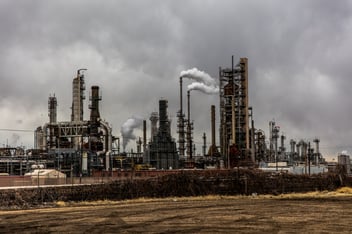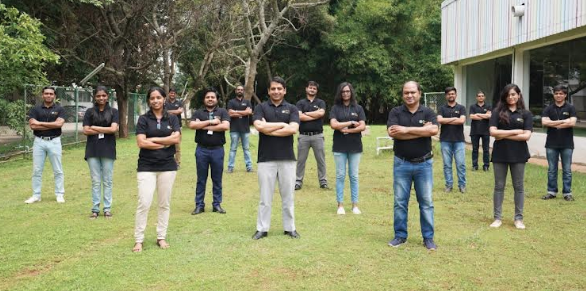Mining Processes: Ambient Air Pollution, Emissions, and the Solution
Mining is a significant economic activity in India. Even on a small scale, it contributes up to 6% to the total cost of mineral extraction. Pollutants and fugitive emissions from the processes involved in mining are suspended in the air and make it unfit for breathing leading to serious respiratory complications.
Table Of Contents:
- The Processes Involved in Mining.
- Stages of Mining that involve Air Pollution.
- Identification of ambient air pollutants at different stages.
- Sources of emission in mining.
- Effects of mining air pollution on human health.
- Solution for air pollution in the mining industry.
- Pure Skies by Devic Earth
- References.
Different Stages of Mining Process: Phases Involved in Mining:
Mining contributes a significant percentage to the annual air pollution in India. Major sources of air pollution in the mining sector are the processes that emit particulate matter (PM) and fugitive emissions.
There are different stages of mining. Mining Air pollution is caused at every stage of the mining process. Major sources of pollution in the mining operations are unpaved roads, blasting, and dust explosion during loading. Apart from air pollution due to mining activities, Significant emission of fine coal particulates (PM1, PM2.5, and PM10), heavy metal dust (PM1, PM2.5, and PM10), are and gases such as NOx, NO2, CO, CO2, and CH4. also a part of the mining process.
Stages of Mining that involve Air Pollution:
-
Excavation:
This is the primary stage that is essential to opening up a mine. The phase one of the operating cycle includes opening up the mine using methods like drilling, blasting, and removal of ore.
-
Pre-Processing:
In the pre-processing stage, Ore stockpiled from underground and open-pit mines is fed into the primary crusher at the process plant. Crushed rock is then transported to the mill.
-
Transportation:
The ore is then transported for further processing at the on-site or off-site plant between the material extraction site and the processing plant.
-
Main Processing:
The main mining operation involves milling, grinding, froth floatation, smelting, and wet grinding.
-
Refining:
This operation involves more advanced processes like hydrometallurgy and electrometallurgy, for highly pure ore.
Identification of ambient air pollutants at different Mining stages:
Activities such as exploration, development, construction, and operational activities result in airborne emissions of pollutants. Mining operations muster large amounts of material, and waste piles comprise small size particles that are easily diffused by the wind. The largest sources of mining air pollution are:
- Particulate matter pollutants are spread by the wind during excavations, blasting, transportation of materials, and wind erosion; which is more frequent in open-pit mining, fugitive emissions, stockpiles, waste dumps, and haulage tracks. Exhaust emissions from mobile sources such as cars, trucks, and heavy equipment raise these particulate levels to an even higher level.
- Gas emissions from the combustion of fuels in stationary and mobile sources, explosions, and mineral processing.
Sources of emission/pollution in mining:
There are three sources of emission of pollutants:
Mobile sources of Air Pollution:
Mobile sources of air pollutants consist of heavy vehicles used in excavation operations, cars used to transport personnel at the mining site, and trucks for transporting mining materials. The level of polluting emissions from these sources depends on the fuel and conditions of the equipment. Even though the individual emissions can be relatively meager but collectively these emissions are of huge concern perhaps. Mobile sources are a major source of emission of particulate matter, carbon monoxide, and VOCs (volatile organic compounds) that contribute significantly to the formation of ground-level ozone
Stationary sources of Air Pollution:
Major gaseous emissions are from the combustion of fuels in power generation installations, drying, roasting, and smelting activities. Many precious metal producers smelt metal on-site, before shipping it to off-site refineries. Generally, gold and silver are produced in fluxing furnaces that perhaps produce elevated levels of mining air pollution like airborne mercury, arsenic, sulfur dioxide, and other metals.
Fugitive Emissions:
Regular emissions generated from industrial combustion processes are systematically passed through scrubber and electrostatic precipitators, vents, and chimneys, and therefore, easily sampled using monitoring equipment. Fugitive emissions, on the other hand, are not easy to monitor during mining stages, since they are not accounted for. It, therefore, becomes difficult to reduce or eradicate them. Air pollution monitoring devices are not capable enough to monitor fugitive emissions.
Various gaseous releases may be identified as fugitive emissions in the mining operations, such as evaporation losses from storage tanks and wastewater treatment facilities, emissions from solid/hazardous waste, a gas emanation from the mineral and mining industries, and loading and unloading discharge. Methane is generated from landfills containing solid and hazardous waste. Further, the microbial anaerobic degradation of waste of this kind produces hundreds of different gases.
In petroleum refineries, volatile organic compounds other than methane, Sox, and NOx are generated during different processes such as crude oil separation, conversion, blending, and storage. The emission of such gases significantly increases the risk of accidents on site. Fugitive emissions are undesirable at the workplace, as well.
Effects of Mining Air Pollution on Human Health:
Throughout different stages of the mining process, several kinds of pollutants are emitted as mentioned above. These pollutants can cause severe health hazards to the human body. Repeated inhalation of mining dust can cause Black Lungs. Minning emissions cause respiratory complications like asbestosis, silicosis, and lung cancer. The pollutants emitted during the process of blasting and drilling can cause Pneumoconiosis and Chronic Obstructive Pulmonary Disease (COPD).
Secondary effects of Air Pollution:
- Regulatory fines
- Costly plant shutdowns
- Sick leaves
- Loss of productivity
- Health hazards
- Union Strikes
- Disharmony with nearby communities
Solution for Air Pollution in Mining Industry:
Mining is a process that involves both indoor and ambient air pollution. Fugitive emissions are a form of pollution that is not easily captured by air pollution control devices. To mitigate air pollution in the mining industry, the only effective solution is pollution control equipment designed to address ambient air pollution in larger areas. Certain technologies only cater to specific pollutants in particular stages of the process but that does not help in the mitigation of air pollution at a larger structure.
There are two categories under which the air pollution control equipment falls into:
- Point Source air pollution control technologies
- Ambient air pollution control technologies.
Point Source air pollution control technologies:
Scrubbers:
So, how do scrubbers remove pollutants? Scrubbers or Wet Scrubbers are devices that trap suspended particles through direct contact with the spray of liquid. Due to countless tiny droplets, the particulates collide and are washed away from the dirty airstream. There are several configurations of wet scrubbers are in use, namely, spray-tower scrubbers, orifice scrubbers, and venturi scrubbers. The efficiency of the scrubber depends upon the relative velocity between the droplets and the particulates.
Electrostatic Precipitators:
Scrubber and Electrostatic precipitators are generally used for removal of particulates from airstreams. In an electrostatic precipitator, as the particulates enter the unit, they get laden with electric charge and are then removed by the influence of an electric field. The charged particles are then attracted to collector plates carrying the opposite charge. The effectiveness of electrostatic precipitators in removing fly ash from the combustion gases of fossil-fuel furnaces accounts for their high frequency of use at power stations.
Baghouse Filters:
Baghouse filters are a collection of fabric-filter bags that remove suspended particulates from the air stream. A baghouse consists of an array of long, narrow bags of about 25 cm (10 inches) in diameter each. These are suspended upside down in a large enclosure. Dust-laden air is blown upward through the bottom of the enclosure by fans. Particulates are trapped inside the filter bags, while the clean air passes through the fabric and exits from the top of the baghouse. This method offers relatively high resistance to airflow, which leads to substantial energy usage for the fan system.
Ambient air pollution control technologies:
Pulsed Radio Wave Based Air Cleaners:
Pulsed radio wave air cleaners use pulsed radio waves in the WIFI spectrum to accelerate the natural clearance of particulate pollutants such as PM10 and PM2.5 in the air. This technology helps mitigate ambient air pollution without passing air through several filters before delivering clean air into the enclosed spaces. These air cleaners come with the advantage of zero maintenance. Only annual routine maintenance of air quality monitors is required.
Pure Skies by Devic Earth:
Devic Earth’s Pure Skies is a breakthrough technology that covers large areas that include fugitives. It addresses very large areas, cleaning ambient air pollution including fugitive and regular emissions. A clean sweep reduces air pollution by removing pollutants such as PM2.5 and PM10 as primary and NOx, and Sox as secondary pollutants. One unit of Pure Skies is sufficient to cover very large areas, at an affordable cost per unit area.
The technology behind Pure Skies is based on pulsed Wi-Fi. Pulsed radio waves are spread across the area to be covered, via base stations and extender units of Pure Skies. This air pollution control device operates in the normal Wi-Fi signal range and is completely safe. Further, it does not interfere with the activities of a manufacturing plant in any way. Pure Skies only accelerates the natural process of dry deposition, whereby minute particles of dust settle in the ground.
Know more about our breakthrough Pulsed Radio Wave-based Clean Air Technology: Pure Skies by Devic Earth.
Start your journey to sustainable mining.
(This article is Co-authored & conceptualized by Shashank Aggarwal, Priya Singh, Kiran Shinde & Ammu Prameela)
References:
https://pubmed.ncbi.nlm.nih.gov/11721598/
https://www.britannica.com/technology/cement-building-material/Extraction-and-processing
https://www.eawag.ch/fileadmin/Domain1/Abteilungen/sandec/publikationen/Chemical_Pollution/ChemPoll-LAMICS_Chapter4.pdf

.svg)

.webp?width=1080&height=1080&name=Free%20Case%20Study%20Steel%20Plant%20(1).webp)






Post Comments